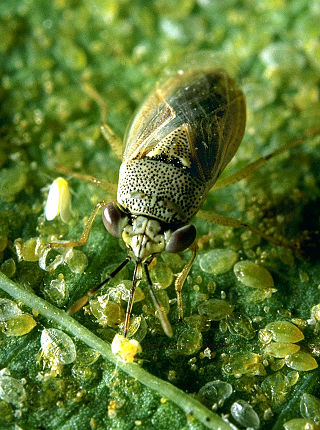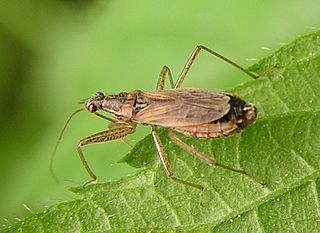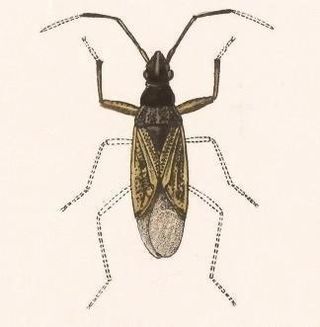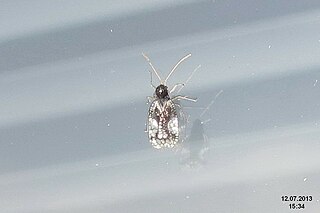
Geocoris is a genus of insects in the family Geocoridae. Commonly known as big-eyed bugs, the species in Geocoris are beneficial predators, but are often confused with the true chinch bug, which is a pest. There are more than 140 described species in Geocoris.

The insect family Nabidae contains the damsel bugs. There are over 500 species in 20 genera. They are soft-bodied, elongate, winged terrestrial predators. Many damsel bugs catch and hold prey with their forelegs, similar to mantids. They are considered helpful species in agriculture because of their predation on many types of crop pests.

The Lygaeoidea are a sizeable superfamily of true bugs, containing seed bugs and allies, in the order Hemiptera. There are about 16 families and more than 4,600 described species in Lygaeoidea, found worldwide. Most feed on seeds or sap, but a few are predators.

The Lygaeidae are a family in the Hemiptera, with more than 110 genera in four subfamilies. The family is commonly referred to as seed bugs, and less commonly, milkweed bugs, or ground bugs. However, while many of the species feed on seeds, some feed on sap (mucivory) or seed pods, others are omnivores and a few, such as the wekiu bug, are carnivores that feed exclusively on insects. Insects in this family are distributed across the world. The family was vastly larger, but numerous former subfamilies have been removed and given independent family status, including the Artheneidae, Blissidae, Cryptorhamphidae, Cymidae, Geocoridae, Heterogastridae, Ninidae, Oxycarenidae and Rhyparochromidae, which together constituted well over half of the former family.

Nysius is a genus of false chinch bugs in the family Lygaeidae. At least 100 described species are placed in Nysius.

The Blissidae are a family in the Hemiptera, comprising nearly 50 genera and 400 species. The group has often been treated as a subfamily of the Lygaeidae but was resurrected as a full family by Thomas Henry (1997).

Cymus is a genus of true bugs in the family Cymidae. There are at least 40 described species in Cymus.

Ligyrocoris is a genus of dirt-colored seed bugs in the family Rhyparochromidae. There are about 14 described species in Ligyrocoris.

Chlorocoris is a genus of stink bugs in the family Pentatomidae. There are about six described species in Chlorocoris.

Stephanitis is a genus of lace bugs in the family Tingidae. There are at least 90 described species in Stephanitis.

Geocoridae is a family of big-eyed bugs in the order Hemiptera. There are more than 290 described species in Geocoridae.

Thyanta is a genus of stink bugs in the family Pentatomidae. There are about 19 described species in Thyanta.

Gampsocorinae is a subfamily of stilt bugs in the family Berytidae. There are about 60 described species in Gampsocorinae.

Udeocorini is a tribe of dirt-colored seed bugs in the family Rhyparochromidae. There are about 17 genera and more than 30 described species in Udeocorini.

Pnirontis is a genus of assassin bugs in the family Reduviidae. There are more than 30 described species in Pnirontis.
Diaditus is a genus of assassin bugs in the family Reduviidae. There are about six described species in Diaditus.
Narvesus is a genus of assassin bugs in the family Reduviidae. There are at least two described species in Narvesus.
Doldina is a genus of assassin bugs in the family Reduviidae. There are about eight described species in Doldina.
Ctenotrachelus is a genus of assassin bugs in the family Reduviidae. There are more than 20 described species in Ctenotrachelus.

Minitingis is a genus of lace bugs in the family Tingidae. There are at least two described species in Minitingis.

















